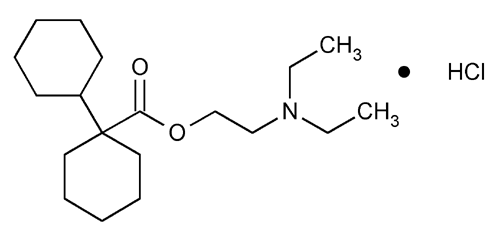Dicyclomine Hydrochloride
[Bicyclohexyl]-1-carboxylic acid, 2-(diethylamino)ethyl ester, hydrochloride.
2-(Diethylamino)ethyl[bicyclohexyl]-1-carboxylate hydrochloride
» Dicyclomine Hydrochloride contains not less than 99.0 percent and not more than 102.0 percent of C19H35NO2·HCl, calculated on the dried basis.
Packaging and storage—
Preserve in well-closed containers.
Identification—
B:
Mix about 5 mL of a 1 in 500 solution of it with about 2 mL of 2 N nitric acid, and add about 2 mL of silver nitrate TS: a white precipitate is formed which is insoluble in nitric acid but soluble in a slight excess of 6 N ammonium hydroxide.
pH  791
791 :
between 5.0 and 5.5, in a solution (1 in 100).
:
between 5.0 and 5.5, in a solution (1 in 100).
Loss on drying  731
731 —
Dry it at 105
—
Dry it at 105 for 4 hours: it loses not more than 1.0% of its weight.
for 4 hours: it loses not more than 1.0% of its weight.
Readily carbonizable substances  271
271 —
Dissolve 500 mg in 5 mL of sulfuric acid TS: the solution has no more color than Matching Fluid D.
—
Dissolve 500 mg in 5 mL of sulfuric acid TS: the solution has no more color than Matching Fluid D.
Assay—
Dissolve about 600 mg of Dicyclomine Hydrochloride, accurately weighed, in 70 mL of glacial acetic acid, add 10 mL of mercuric acetate TS and 1 drop of crystal violet TS, and titrate with 0.1 N perchloric acid VS to a blue endpoint. Perform a blank determination, and make any necessary correction. Each mL of 0.1 N perchloric acid is equivalent to 34.60 mg of C19H35NO2·HCl.
Auxiliary Information—
Please check for your question in the FAQs before contacting USP.
Chromatographic Column—
| Topic/Question | Contact | Expert Committee |
| Monograph | Elena Gonikberg, Ph.D.
Senior Scientist 1-301-816-8251 |
(MDGRE05) Monograph Development-Gastrointestinal Renal and Endocrine |
| Reference Standards | Lili Wang, Technical Services Scientist 1-301-816-8129 RSTech@usp.org |
USP32–NF27 Page 2128
Pharmacopeial Forum: Volume No. 34(5) Page 1152
Chromatographic columns text is not derived from, and not part of, USP 32 or NF 27.
